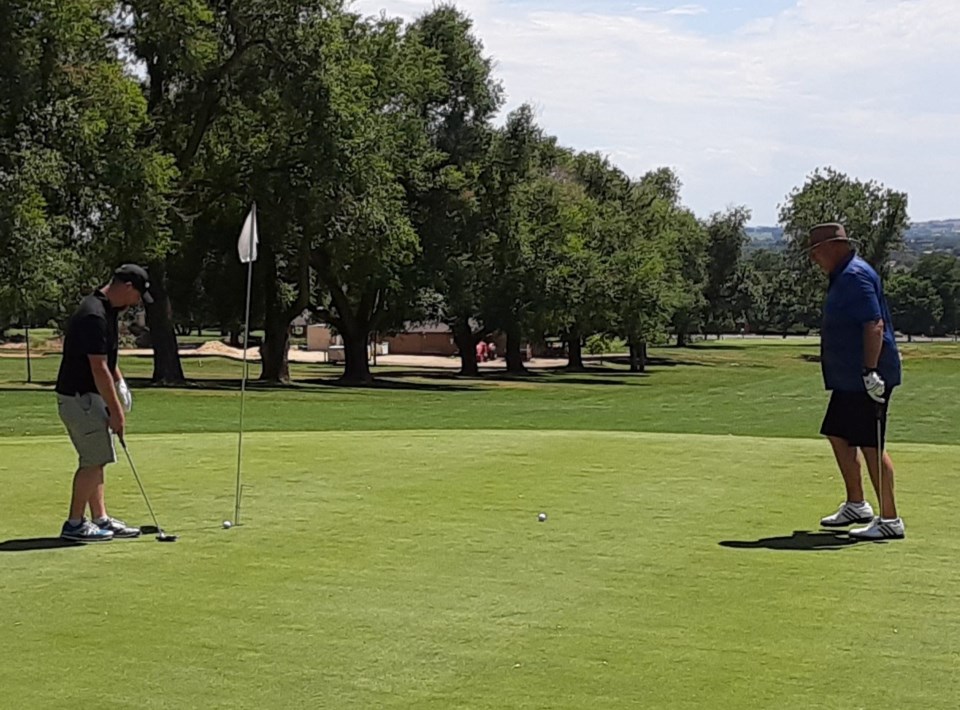Look at any of Longmont’s three public golf courses and the view resembles a time before COVID-19 took over. Friends and families enjoy the open spaces and try to find the green without taking too many swings. It isn’t until patrons return to the clubhouse, don their masks and sanitize their hands that the reality of an ongoing pandemic becomes apparent again.
“You see the plexiglass, so that kind of brings you back to reality pretty quick,” Keith Martin said. “You see people masked up, so that brings you back to reality. But most of that five hours you’re going to be in a golf cart breathing in fresh air. During those five hours you are not even dealing with reality or thinking about it. So I think it’s a tremendous escape right now.”
Martin has been the Professional Golf Association pro at Twin Peaks Golf Course for the past 14 years.
Longmont has three public courses ranging in size and difficulty. Sunset Golf Course was first laid out in 1925 and still offers nine picturesque holes in the older part of town. But two championship courses with 18 fairways and greens bookend either side of the municipality, and also are open for business.
Twin Peaks was completed in 1977 and features elevated greens and water hazards on seven holes, while Ute Creek is the newer golf course in town and offers wider fairways for players. Both courses can be as short as 5,500 yards for beginners, to around 7,000 yards for experienced golfers.
“If you’re playing Twin Peaks and you’re playing all the way back to the back tees, the fairways are significantly more narrow,” Martin said. “And those obstacles create, a lot of times, a tougher second shot. Our greens are all mounded and it’s tough to get inside those mounds sometimes and get your ball to where you can get a good putt and birdie. I’m biased of course, but if our greens are running at a really good speed, and they are right now, our course is really hard to score on from the back tee boxes.”
Sam Linnenburger, the PGA pro at Ute Creek, said with 50 bunkers, five lakes, two creeks and lots of native grass, his course also presents plenty of challenges for scratch golfers.
“We have been very busy since we reopened,” Linnenburger said via email. “We are following all the Boulder County health guidelines. Anyone that likes outdoor activities will enjoy golf. Especially now, during these difficult times people need a relaxing and fun escape.”
While professionals are drawn to championship courses, Martin said he still has a lot of love for the more modest nine-hole Sunset course near downtown Longmont. He started working there over 30 years ago and after getting certified by the PGA in 1992, he became a professional instructor at Sunset. From 2006 to 2008 he was the club pro for both Sunset and Twin Peaks.
“Truthfully, of all the three golf courses, it is by far, for the really good player, a tremendous challenge,” Martin said. “They have the small little greens and if your ball rolls through those greens and falls off into the rough, the grass has obviously been there for over 100 years. It is so difficult to hit little pitches when you miss the greens, so there's a major premium on hitting iron shots at Sunset. The golf course has so much character. The rolling hills, the small little greens, all the houses around the hills. There’s nothing quite like it and I can’t say enough good things about it.”
Sometimes the perfect shot happens every few days at a local course, and at other times, weeks go by without one being reported. New hole-in-one club members in Longmont have included Brad Frederking at Ute Creek on June 8 and Penny Lykins at Sunset on June 29.
“Ute Creek is unique in that we have five par 3's while most par 72 courses have four par 3's,” Linnenburger said. “ Most of our par 3's are a short iron and with the extra par 3, we see quite a few holes-in-one every season. It's customary to buy everyone a round if you make a hole-in-one so we don't hear from everyone that makes one, especially if we have a full clubhouse.”
Editor's note: Keith Martin's first name was incorrect in the original posting of this story



